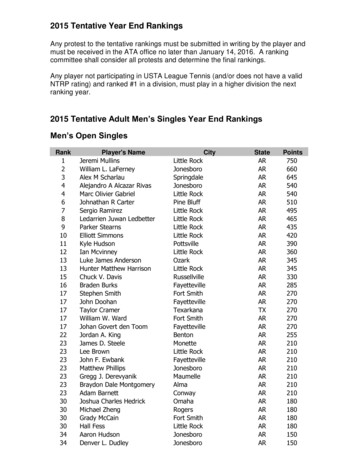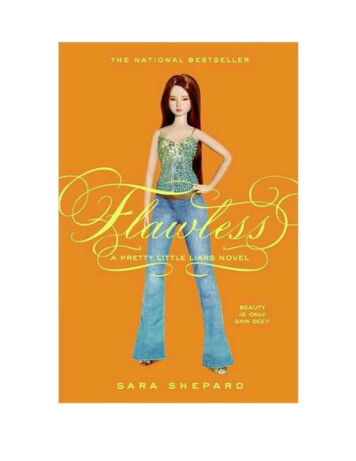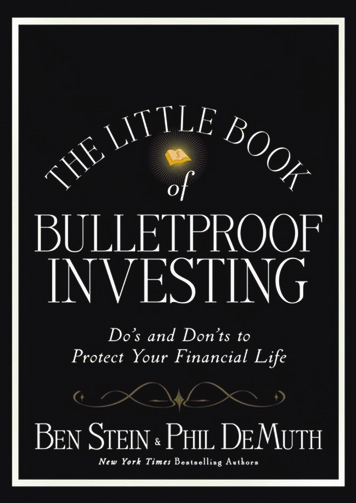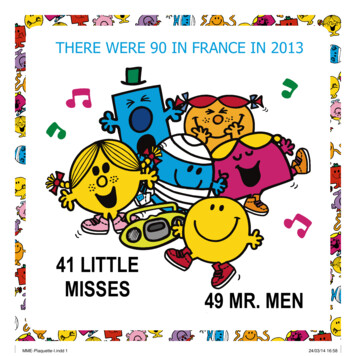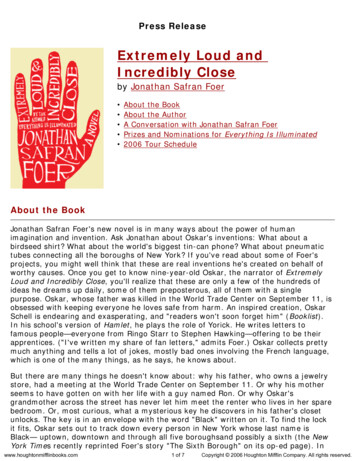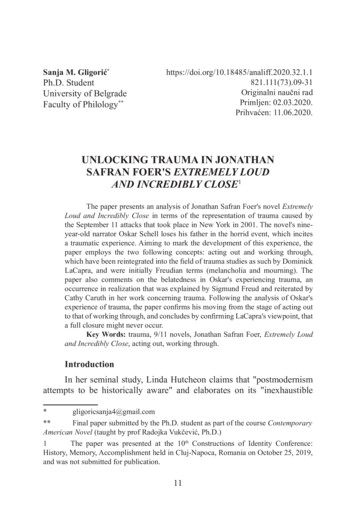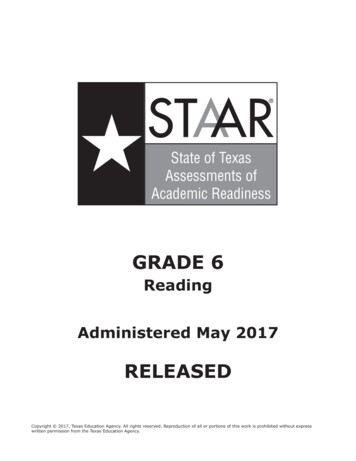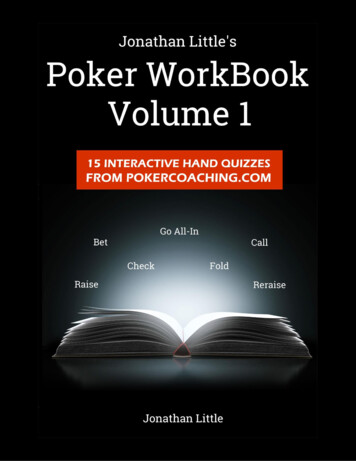
Transcription
1
Jonathan Little’s Poker Workbook: Volume 115 Interactive Hand Quizzes From PokerCoaching.comBy Jonathan LittleCover Image Copyright: kostsov / 123RF Stock Photohttps://www.123rf.com/profile kostsov2
Exclusive BonusAs a bonus for purchasing this book, I am making the 15 hands that are presentedin this book available to you as interactive quizzes.To access the 15 interactive hand quizzes, visit:http://pokercoaching.com/workbook/bonus3
AcknowledgmentsHuge thanks to my business partners Dan Stanley and Albert Hart for helpingmake this book look presentable. Infinite thanks are owed to Suzan Baroni andKen Adams for editing the text. Finally, thanks to you, my students. You inspiredme to create PokerCoaching.com, which in turn inspired this book. My workwould not exist without you. Thank you for letting me live my dream.4
IntroductionMy training site PokerCoaching.com started off as an experiment to see if I couldfind a better way to teach my students how to develop the fundamental skillsrequired to succeed at poker. While watching training videos of world-classplayers play in real time is great, I thought the lack of interactivity was a problem.I decided to develop interactive quizzes so my students could compare their skillsto mine in real time, getting immediate feedback on spots where I disagree withtheir strategies. After putting in just a bit of time working on their games, mystudents started seeing improvements, and eventually, significant, life-changingwins.Jonathan Little’s Poker WorkBook: Volume 1 is a brief sampling of what you canexpect at PokerCoaching.com. The only difference is PokerCoaching.com’s quizzesare in a video format whereas these are in written form. This book presents 15hands, five from me (Jonathan Little), five from Matt Affleck, and five from AlexFitzgerald. While our strategies may differ from time to time, we are all long-termprofessional poker players who have stood the test of time. By studying ourstrategies and comparing your skills to ours, you will be able to see the holes inyour game and can then work to plug your leaks.In each quiz, there will be questions with corresponding answers ranked from 0 to10 points. While these scores are arbitrary, they are meant to give you anunderstanding of how we think each answer fares in relation to the others.Sometimes, a few answers will be close and other times, there is a clearly correctanswer. If you find that you are often choosing the right answer, or an answerthat gets a high score, you are playing well. If you seem to choose answers thatreceive 0 points almost every time, you have lots of work to do!I hope you enjoy progressing through this book as much as I enjoyed putting ittogether. While this is only Volume 1 of the series, the plan is to have many morevolumes so you can continue improving your skills using this printed format. If youlike testing yourself against world-class players, be sure to sign up for your freetrial of PokerCoaching.com by visiting http://pokercoaching.com/workbook/free.Thanks for reading and have fun! Jonathan Little5
Chapter 1 by Jonathan LittleAbout Jonathan LittleJonathan Little is a professional poker player, coach, author, and commentator.He has won two World Poker Tour titles and has final tabled two others, earninghim the Season 6 World Poker Tour Player of the Year award. He has total liveearnings in excess of 6,600,000. Jonathan owns and operates the training sitesPokerCoaching.com and FloatTheTurn.com, and posts a weekly educational blogand podcast at JonathanLittlePoker.com. When he is not traveling the high stakeslive tournament circuit, he is home in Manhattan with his wife Amie and sonJames.You can follow Jonathan on Twitter @JonathanLittle.6
Set UpThe following hands are from the final table of a tough 10,000 buy-in High Rollerevent. You have a big stack of roughly 120 big blinds. The six other stacks at thetable vary, with the shortest being only 11 big blinds. Your opponents probablythink you are on the tight side, but certainly competent and capable of makingplays when it makes sense. You are already in the money and the tournamentuses a standard payout structure.7
Getting Value from the Effective Nuts While Protecting Your RangeWith blinds at 100,000/200,000 with a 25,000 ante, you pick up A-K in the lojackseat at a 7-handed final table with a 24,000,000 stack.Should you:1.FoldCallRaise to 500,000Raise to 700,0008
Score:1.Fold (0 Points)Call (1 Point)Raise to 500,000 (10 Points)Raise to 700,000 (6 Points)You should raise with all your playable hands. Perhaps if your opponents wereterrible, there would be some merit in limping with some hands, but even then,A-K should be raised for value. When choosing your raise size, choose an amountthat allows some worse hands to call, allowing you to extract additional valueafter the flop.9
You raise to 500,000 and only a good, tight aggressive player with 10,400,000 callsfrom the big blind.The flop comes Ah-Ac-8c. The pot is 1,300,000. Your opponent checks.Should you:2.CheckBet 400,000Bet 700,000Bet 1,200,00010
Score:2.Check (2 Points)Bet 400,000 (10 Points)Bet 700,000 (8 Points)Bet 1,200,000 (5 Points)As the preflop raiser, a tiny flop bet should be your default play on uncoordinatedboards that should connect well with your range. A-A-x is as uncoordinated asthey come. Betting larger is only a good idea if it is obvious due to physical tellsthat your opponent likes his hand and will happily pay off large bets on all threestreets.11
You bet 400,000 and your opponent calls.The turn is the (Ah-Ac-8c)-2s. The pot is 2,100,000. Your opponent checks.Should you:3.CheckBet 600,000Bet 1,300,000Bet 2,000,00012
Score3.Check (0 Points)Bet 600,000 (5 Points)Bet 1,300,000 (8 Points)Bet 2,000,000 (10 Points)In general, you would like to apply maximum pressure on the opponent due tohim having a medium stack and wanting to outlast the short stacks. Betting largeensures he either gets all-in on the turn or river with his Aces while alsoprotecting against flush draws. The only time a large bet does not maximize valueis when the opponent has exactly a marginal made hand, but even then, he maydecide your large turn bet indicates lots of bluffs in your range, which may inducehim to hero-call.You bet 2,000,000. Your opponent thought for a while before folding 9c-7c, one ofthe draws you don’t mind forcing to fold.13
Blind Versus BlindWith blinds at 125,000/250,000 with a 30,000 ante, everyone folds to the smallblind, a good, loose aggressive player with a 12,200,000 effective stack who limps.You have Ac-9d in the big blind.Should you:1.CheckRaise to 500,000Raise to 850,000Raise to 1,200,00014
Score:1.Check (7 Points)Raise to 500,000 (3 Points)Raise to 850,000 (10 Points)Raise to 1,200,000 (4 Points)It is important to first try to figure out the small blind’s limping strategy. In thehigh stakes games, at this point in time, most players limp with their entireplayable range from the small blind when everyone folds to them. Keeping that inmind, against an extremely wide range, you should raise your best hands forvalue. While A-9 is far from premium, it can extract significant value from theopponent’s worse A-x hands as well as various hands containing two somewhatcoordinated cards. If for some reason you thought your opponent planned to limpwith the intention of reraising, you should be more inclined to check to ensureyou get to see the flop. When choosing your raise size, pick an amount he wouldcall with some portion of his range, while forcing him to fold some amount of thetime. Notice if you min-raise, he will call essentially every time, and he won’t bemaking much of a mistake, due to his excellent pot odds. However, if you raisetoo large, he will only put money in with hands that dominate yours.15
You raise to 850,000 and your opponent calls.The flop comes Js-8s-4c. The pot is 1,900,000. Your opponent checks.Should you:2.CheckBet 700,000Bet 1,200,000Bet 1,900,00016
Score:2.Check (5 Points)Bet 700,000 (10 Points)Bet 1,200,000 (8 Points)Bet 1,900,000 (4 Points)Both betting and checking are fine, but in general, you should use a small bet thatforces your opponent to play somewhat straightforwardly by making most of hisjunk and marginal hands fold. While checking behind is perfectly fine, you willoften find yourself in a difficult spot if he bets the turn and river. Also, you havelots of backdoor draws, so betting can never be too bad unless you expect tofrequently get check-raised.17
You bet 700,000 and your opponent calls.The turn is the (Js-8s-4c)-6d. The pot is 3,300,000. Your opponent checks.Should you:3.CheckBet 900,000Bet 1,700,000Bet 3,300,00018
Score:3.Check (10 Points)Bet 900,000 (6 Points)Bet 1,700,000 (2 Points)Bet 3,300,000 (4 Points)While you could keep betting to try to make your opponent fold all hands worsethan a Jack, checking with the intention of giving up is fine. If you think he willrarely fold his best hands to significant pressure and may even decide to hero-calldown, bluffing too often becomes a significant mistake. If you decide to bet, youshould either bet small with the intention of firing again on the river or large withthe intention of giving up on most rivers.19
You check behind.The river is the (Js-8s-4c-6d)-Th. The pot is 3,300,000. Your opponent bets1,800,000 out of his 10,850,000 stack.Should you:4.FoldCallRaise to 5,000,000Go all-in20
Score:4.Fold (9 Points)Call (2 Points)Raise to 5,000,000 (10 Points)Go all-in (9 Points)This is an interesting spot because, in reality, you should likely continue bettingthe turn with Q-9 and 9-7, but there is no way for your opponent to know that isthe strategy you are likely to employ. You should, however, definitively checkbehind with T-T, which improved to a set. When figuring out which hands to bluffon the river, you should strive to have a 9 in your hand because having a 9 makesit much less likely your opponent has the straight. While your overall river rangeshould rarely raise because most of it will be either marginal made hands or junk,you should raise as a bluff from time to time, because there are also a fewpremium hands you want to raise for value. Since most of your hands that have a9 also have a pair, it is fine to bluff with all your unpaired 9s, although that maynot be the case if you use an overly aggressive preflop strategy that includesraising all combinations of 9-5, 9-3, and 9-2. It is difficult to know which raise sizeis best, but in general, most players will call a raise with the same range whenfaced with an all-in or almost an all-in, often making the smaller size ideal whenbluffing (just don’t let your opponents know your strategy!).You raised to 5,000,000. Your opponent folded Kc-7c, which he was also bluffingwith. It is impossible to know whether or not he would have folded a made hand,making it difficult to know if your bluff was great or hopelessly optimistic.21
Tricky Preflop SpotWith blinds at 125,000/250,000 with a 30,000 ante, a good, loose aggressiveplayer raises to 550,000 out of his 8,500,000 stack from the lojack (also firstposition in this situation). You pick up Ad-Js in the hijack seat.Should you:1.FoldCallReraise to 1,200,000Reraise to 1,500,00022
Score1.Fold (8 Points)Call (6 Points)Reraise to 1,200,000 (7 Points)Reraise to 1,500,000 (10 Points)While calling may seem like a good idea, because in general, you don’t want toplay a large pot with A-J against what is likely a strong early position raise, sinceall your opponents play well, it is too likely that someone yet to act will reraise,forcing you to fold. Also, the initial raiser could easily have you dominated, whichis not where you want to be. So, folding is a perfectly viable option. Reraising isalso a decent option. While it will often result in the initial raiser going all-in, it willput him in a tough spot with the weaker part of his range, such as 7-7, A-J, K-Q,and 9-8s. That said, if he is simply going to go all-in with his entire preflop raisingrange, either calling or folding is a much better strategy because you will usuallynot be getting the correct pot odds to justify calling an all-in.23
You 3-bet to 1,500,000. Everyone folds around to the preflop raiser, who pushesall-in for 8,500,000 total.Should you:2.FoldCall24
Score:2.Fold (10 Points)Call (0 Points)The first thing you should consider when deciding whether or not to call an all-inare your pot odds. This time, you have to put in roughly 7,000,000 to win a potthat will be 17,530,000 if you call, meaning you need to win 40% of the time tobreak even (7M/17.53M). While calling may be tempting because you beat allyour opponent’s bluffs and are flipping against the medium pairs, you must makean easy fold. Against a reasonable range including 9-9 , A-Js , A-Qo , and K-Qs,your A-Jo only has 31% equity. If the opponent is instead pushing 7-7 , A-Ts , A5s – A-2s, A-Jo , K-Js , and K-Qo, your A-Jo still only has 43% equity, making itroughly break-even. So, unless the opponent is an absolute lunatic, you shouldfold.You decided to fold. Your opponent had T-T, one of the few hands you wereflipping against. Even though you should have called if you knew your opponent’sexact hand, folding will work out well for you in the long run because you were inbad shape against your opponent’s range.25
Standard Big Blind SituationFour-handed with blinds at 150,000/300,000 with a 45,000 ante, a good, tightaggressive player raises to 650,000 out of his 20,600,000 stack from the button.The small blind folds. You have Jd-2d in the big blind.Should you:1.FoldCallReraise to 1,500,000Reraise to 2,100,00026
Score1.Fold (2 Points)Call (9 Points)Reraise to 1,500,000 (3 Points)Reraise to 2,100,000 (10 Points)Both calling and folding J-2s are perfectly fine options when facing a small raisefrom late position, but when playing against strong opponents who are not raisingwith only premium hands, it is important to develop a bluffing range. In general,you should call with a decently wide range from the big blind when facing a smallraise, so if your opponent is inclined to 4-bet or fold when facing a reraise, yourbluffs should be hands that are on the cusp of playability. This often includesoffsuit K-x, Q-x, and suited J-x hands. While you should not reraise too often withthese holdings, doing so will make you much more difficult to play against.27
You 3-bet to 2,100,000. Your opponent calls.The flop comes Ad-Qh-6s. The pot is 4,500,000.Should you:2.CheckBet 900,000Bet 1,800,000Bet 3,200,00028
Score:2.Check (1 Point)Bet 900,000 (8 Points)Bet 1,800,000 (10 Points)Bet 3,200,000 (7 Points)While J-high is far from a strong hand, betting on a board that should be good foryour range is the only play that makes sense. Really, there should be very fewhands you plan to check-fold on high card boards as the preflop reraiser. Whenchoosing your bet size, you have to determine if you are going to bet once withthe intention of giving up if called, or multiple times. If you plan to bet once, youshould bet large, but if you plan to barrel on various turns, you should bet smaller.Also, you will tend to find that most strong players are unwilling to release evenmarginal pairs to one bet, which should lead you to prepare to fire multiplebullets.29
You bet 1,800,000. Your opponent calls.The turn is the (Ad-Qh-6s)-Kc. The pot is 8,100,000. Your opponent has16,700,000 remaining in his stack.Should you:3.CheckBet 3,000,000Bet 5,500,000Bet 7,200,00030
Score3.Check (3 Points)Bet 3,000,000 (10 Points)Bet 5,500,000 (4 Points)Bet 7,200,000 (6 Points)While you would have preferred to see a diamond on the turn, a King is not theworse card, as it gives you a gutshot straight draw. While betting on this turn feelsa bit optimistic because your opponent will never fold an Ace and most of hisQueens should have at least a gutshot straight draw to go along with it, if youconsider your entire range, you will see that you have a significant rangeadvantage. Assuming you want to remain balanced, you should continue bettingthis hand, mainly because you certainly want to keep betting your sets and twopairs. When choosing your bet size, you should choose an amount that either setsup a reasonably sized river all-in or ensures your opponent will fold all his nonpremium hands.You bet 3,000,000. This time the opponent folded Qd-9d, which is one of thehands your turn bet targeted. If your opponent called your turn bet, you shouldalmost certainly continue betting the river, again due to wanting to remainbalanced when betting your sets and two-pairs.31
Flopping Two-PairThree-handed with blinds at 250,000/500,000 with a 75,000 ante, a good, tightaggressive player raises to 1,100,000 out of his 20,500,000 stack. You are in thesmall blind with 9c-8c with an 18,600,000 stack.Should you:1.FoldCallReraise to 2,600,000Reraise to 3,200,00032
Score:1.Fold (1 Point)Call (10 Points)Reraise to 2,600,000 (5 Points)Reraise to 3,200,000 (8 Points)Both calling and reraising are fine options. Given you do not want to reraise andhave to fold to an all-in, calling with your decently strong suited connector makeslogical sense. If for some reason you thought the raiser would fold too often to areraise, that would become the best play.33
You call and the big blind calls as well.The flop comes 9d-8d-6h. The pot is 3,500,000.Should you:2.CheckBet 1,100,000Bet 2,500,000Bet 5,000,00034
Score:2.Check (8 Points)Bet 1,100,000 (2 Points)Bet 2,500,000 (10 Points)Bet 5,000,000 (4 Points)While you should rarely have a leading range, the key time to consider leading iswhen the flop is incredibly good for your range and quite bad for your opponents’ranges. While both opponents could have easily connected with this board, it is abit of a disaster if the flop checks through because there are lots of turn cards thatcould either improve an opponent to the best hand or make it difficult for you toget paid off. Leading in this situation with some of your best value hands anddraws has some merit, especially if you think the preflop raiser will often take thepassive route when checked to.35
You bet 2,500,000 and only the button calls.The turn is the (9d-8d-6h)-8h. The pot is 8,500,000 with 15,000,000 remaining inyour stack.Should you:3.CheckBet 3,500,000Bet 7,000,000Go all-in36
Score:3.Check (2 Points)Bet 3,500,000 (10 Points)Bet 7,000,000 (5 Points)Go all-in (2 Points)When you turn the full house, you should certainly keep betting. It is quite likelythe opponent has an overpair, top pair, or a draw that will be unable to fold.Checking, looking to either check-call or check-raise is not a good strategybecause many players will check behind with their marginal hands on this turnand if they do bet, it will often be with the intention of folding to a check-raise.Betting small ensures you continue to build the pot against almost all of youropponent’s range whereas making a large bet will force your opponent to fold hisdraws and marginal made hands.37
You bet 3,500,000 and your opponent calls.The river is the (9d-8d-6h-8h)-4d. The pot is 15,500,000 and you have 11,400,000remaining in your stack.Should you:4.CheckBet 3,500,000Bet 8,000,000Go all-in38
Score:4.Check (2 Points)Bet 3,500,000 (3 Points)Bet 8,000,000 (4 Points)Go all-in (10 Points)On the river, the only play that makes sense is to go all-in for about 2/3 of the sizeof the pot. As on the turn, if you check, your opponent will check behind withmany of his marginal made hands, opting to only bet with full houses and flushes,which will call your 2/3 pot bet. The only hands you may miss value from arebusted straight draws, but even then, those hands should strongly consider givingup on the river because when you check, you could easily have a decently stronghand. While most competent opponents will fold some of their top pairs andoverpairs, betting is still the right play as it allows you to bluff with some of yourbusted draws.You decided to go all-in. This time your opponent made a good fold with Qh-9h.You continued playing your best but eventually lost heads-up when your 3-3 couldnot hold against A-5 for all the money. It is not all bad though, because youcashed for 175,000.39
Chapter 2 by Matt AffleckAbout Matt AffleckMatt Affleck has been supporting himself through poker since 2006, cashing forover 2,600,000 in live poker tournaments. While attending the University ofWashington, he developed his poker skills through single-table and multi-tabletournaments online. After Black Friday, Matt decided to stay in the USA and hastraveled the live circuit playing both tournaments and cash games throughout thecountry. His personal site MattAffleck.com is an excellent educational resourcefor poker players of all skill levels.You can follow Matt on Twitter @mcmattopoker.40
Set UpThe following hands were played in a 5/ 5/ 10 No-Limit Hold’em cash gamesession at Bellagio. This game was live streamed on Twitch with hole cards shownon a 30-minute delay. The minimum buy-in was 1,000 and the maximum was 2,000. You started the session with 2,000. It is important to note that there arethree blinds in this game of 5, 5, and 10, which occasionally changes thegeneral strategy a bit compared to a “normal” two-blind game.The game consists of a few regulars who play all the time as well as a fewrecreational players who are playing due to the game being streamed.41
Tough Spot with an OverpairIn your first hand at the table, you are dealt Q-Q under the gun and raise to 40.Only the button, a loose, aggressive, and competent recreational player calls. Theflop comes 9h-4h-4d. The pot is 100.Should you:1.CheckBet 30Bet 50Bet 70Bet 10042
Score:1.Check (4 Points)Bet 30 (2 Points)Bet 50 (10 Points)Bet 70 (5 Points)Bet 100 (1 Point)This is a very uncoordinated flop that you should continuation bet at a highfrequency. Due to the low nature of the flop (4s and 9s compared to Jacks andAces), it is more likely that both players missed. You will want to continuation betas a bluff with most of your unpaired hands, therefore you should bet with yourstrong hands as well. If you were in position, I would prefer a small bet of around33% pot because this flop is so uncoordinated and should not significantlyimprove either player’s range. Since you are out of position, I prefer sizing up a bitto 50% pot. This charges his hands like A-J more to call and realize their equity.Due to the lack of coordination on this board, I dislike the larger bet sizes of 70and 100. It will be hard for the opponent to have a hand that can call a bet thatlarge.43
You bet 50 and the opponent calls.The turn is the (9h-4h-4d)-2s. The pot is 200.Should you:2.CheckBet 50Bet 100Bet 150Bet 20044
Score:2.Check (6 Points)Bet 50 (1 Point)Bet 100 (10 Points)Bet 150 (5 Points)Bet 200 (2 Points)Thinking about your opponent’s range, it is safe to assume his range is roughly a4, 9, Ace-high with two over cards, flush draws, and smaller pocket pairs. In thissituation, you are either way ahead or way behind. You do not have a ton ofhands to bluff with due to the lack of draws. Your best bluffs are flush draws andhands with two over cards to the 9. Since you are way ahead or way behind, youshould use a smaller bet sizing with a hand that should frequently be ahead ofyour opponent’s hand. For this reason, I prefer a 50% pot bet of 100. If you betlarger ( 150 or 200), there is a chance your opponent mostly calls with handsthat beat you. Checking is also an option since you may only get one more streetof value from your hand. Against curious opponents though, I always preferbetting to checking.45
You bet 150 and your opponent calls. The river is the (9h-4h-4d-2s)-6d. The potis 500.Should you:3.CheckBet 150Bet 250Bet 400Bet 50046
Score:3.Check (5 Points)Bet 150 (1 Point)Bet 250 (10 Points)Bet 400 (8 Points)Bet 500 (3 Points)The board ran out quite cleanly for you. None of the obvious draws completedand if you had the best hand on the flop, you are still likely to have the best hand.Given the obvious flush draw missed, you should continue betting with your bestmade hands, including Q-Q. This allows you to bluff with a few of your misseddraws in order to possibly fold out hands like weak 9s, 8-8, and 7-7. If the riverwas the 6h instead of the 6d, you should instead check Q-Q.Choosing the right bet size on the 6d river is tricky. You could choose a large betsize of near full pot that allows you to bet with polarized range of effective nuts ornothing. You could alternatively choose a smaller size of 50% pot that allows youto bet a wider range of decently strong, but non-nut hands like T-T and A-9,looking to target the weaker parts of your opponent’s range. Since your opponentcould still be slow playing a hand like 9-9 or A-4, and you do not have many 4s inyour range, I think the smaller size is better. It encourages calls from manymarginal hands you beat, like T-9, while allowing you to bluff with the few bluffsin your range for a cheap price.47
You bet the slightly suboptimal amount of 400. Your opponent raises to 1,400.Should you:4.FoldCallGo all-in48
Score:4.Fold (10 Points)Call (2 Points)Go all-in (0 Points)When faced with this river raise, you have an incredibly easy fold. You bet your QQ for thin value since the flush draw missed. Your opponent is indicating that hehas a premium hand such has 9-9, 6-6, 2-2 or A-4. You have no reason to believehe is not acting in an honest manner. If he is bluffing, his most likely holdings areflush draws or a 9. Since you have the Qh in your hand, you can eliminate a fewbusted flush draws such as Qh-Jh and Qh-Th from this opponent’s range, reducingthe possible bluffs he can have.You make the wise fold and later find out by watching the replay of the streamthat you were against 9-9, for the flopped full house.49
Set on a Scary BoardEveryone folds to the player in the hijack who raises to 30. You look down at 6d6h in the cutoff.Should you:1.FoldCallReraise to 90Reraise to 120Reraise to 15050
Score:1.Fold (0 Points)Call (10 Points)Reraise to 90 (5 Points)Reraise to 120 (3 Points)Reraise to 150 (1 Point)In general, you just want to call preflop raises with your small pocket pairs. Thesehands tend either hit hard with effective nut hands or completely miss, some saythey are hot or cold. In these scenarios, you want to keep pots small preflop sincethere are many flops where you won’t want to continue. For that reason, calling isthe standard play in this situation. If your opponent in the hijack is raising withtoo many hands, you could make a sophisticated play of 3-betting the smallpocket pair, allowing you to take the betting initiative. Instead of your opponentbetting the flop and winning most of the time when you fail to connect with youboard, you have the ability to easily pick up the pot when your opponent fails toconnect.51
You call, as do the button and big blind.The flop comes Ks-Tc-6s. The pot is 135. The big blind and the initial raiser checkto you.Should you:2.CheckBet 50Bet 100Bet 135Bet 20052
Scores:2.Check (0 Points)Bet 50 (2 Points)Bet 100 (10 Points)Bet 135 (8 Points)Bet 200 (6 Points)You definitely want to bet this flop. While you should occasionally slow play withyour sets, this is not the right time. The pot is multiway, and the board is fairlycoordinated, containing two high cards. It is extremely likely someone elseconnected with this board and will pay off your bet. Since the board iscoordinated, you should often bet a bit larger than you normally would. I preferbetting 75% pot, or 100. Using a larger size would make it difficult for you to getpaid off by worse made hands when your holding is a bit weaker, such as whenyou have K-Q or K-J, because a large bet size would force most worse made handsto fold. Remember to always take your entire range into consideration, not justyour exact hand.53
You bet 100 and only the button calls.The turn is the (Ks-Tc-6s)-Qs. The pot is 335.Should you:3.CheckBet 150Bet 250Bet 300Bet 40054
Score:3:Check (7 Points)Bet 150 (4 Points)Bet 250 (10 Points)Bet 300 (5 Points)Bet 400 (1 Point)The majority of poker players are scared to bet this obviously scary turn card withbottom set. However, there are a lot of hands that can call a reasonable bet thatyou can extract value from, such as K-Q, K-J, Q-J, and any hand containing the Asor Js. The only hands that can confidently raise your bet are flushes (sometimesthe opponent will just call with weaker flushes) and perhaps A-J (again, this handmay just call). I believe most opponents play too passive in this spot, so I chooseto bet with my sets most of the time. I like a nice 67% pot bet of 250 to chargethe draws a hefty price to see the river. If you get raised, you should usually notfold, mainly because you have 10 clean outs to the full house and will often begetting the correct pot odds. On top of that, your opponent may be semi-bluffing,making you a significant favorite.You bet 250 and your opponent folds.55
Flopping an OverpairEveryone folds to a loose, aggressive recreational player who raises to 30 fromthe hijack seat. Everyone folds to you in small blind with 8s-8c.Should you:1.FoldCallReraise to 90Reraise to 120Reraise to 15056
Score:1.Fold (0 Points)Call (10 Points)Reraise to 90 (2 Points)Reraise to 120 (6 Points)Reraise to 150 (4 Points)Again, you have one of those hot and cold hands with 8-8. Although, as your pairgets larger, 3-betting for value becomes a more comfortable option. Had the raisecome from the button, a 3-bet may be in order, but against the hijack, you shouldtend to call, mainly because the hijack should only be raising with reasonablystrong hands. If you decided to 3-bet, you should make it about four times youropponent’s
Jonathan Little is a professional poker player, coach, author, and commentator. He has won two World Poker Tour titles and has final tabled two others, earning him the Season 6 World Poker Tour Player of the Year award. He has total live earnings in excess of 6,600,000. Jonathan owns and operates the training sites
